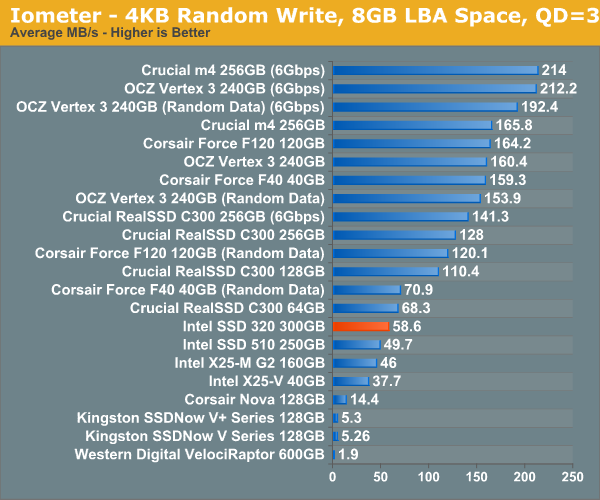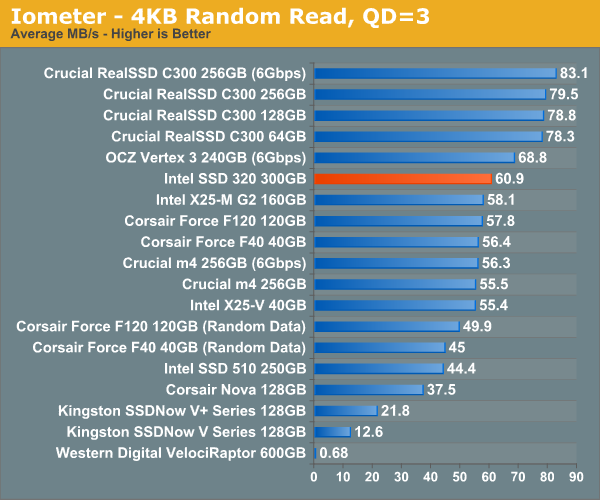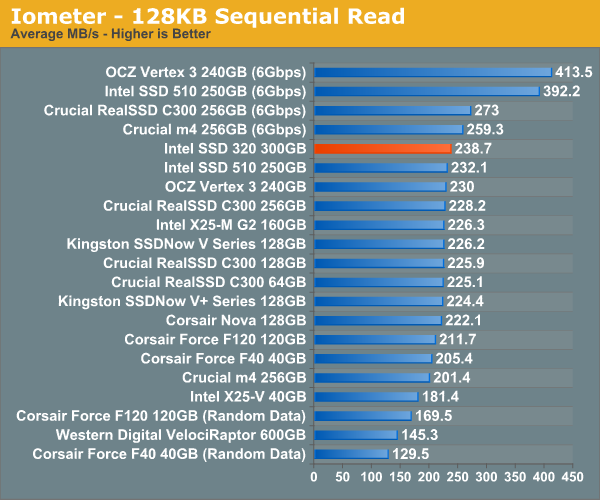The Intel SSD 320 Review: 25nm G3 is Finally Here
by Anand Lal Shimpi on March 28, 2011 11:08 AM EST- Posted in
- IT Computing
- Storage
- SSDs
- Intel
- Intel SSD 320
Random Read/Write Speed
The four corners of SSD performance are as follows: random read, random write, sequential read and sequential write speed. Random accesses are generally small in size, while sequential accesses tend to be larger and thus we have the four Iometer tests we use in all of our reviews.
Our first test writes 4KB in a completely random pattern over an 8GB space of the drive to simulate the sort of random access that you'd see on an OS drive (even this is more stressful than a normal desktop user would see). I perform three concurrent IOs and run the test for 3 minutes. The results reported are in average MB/s over the entire time. We use both standard pseudo randomly generated data for each write as well as fully random data to show you both the maximum and minimum performance offered by SandForce based drives in these tests. The average performance of SF drives will likely be somewhere in between the two values for each drive you see in the graphs. For an understanding of why this matters, read our original SandForce article.

Random write speed is improved compared to the 510 thanks to Intel's controller, but we're only looking at a marginal improvement compared to the original X25-M G2.
Many of you have asked for random write performance at higher queue depths. What I have below is our 4KB random write test performed at a queue depth of 32 instead of 3. While the vast majority of desktop usage models experience queue depths of 0 - 5, higher depths are possible in heavy I/O (and multi-user) workloads:


Random read performance has always been a strong point of Intel's controller and the 320 is no different. While we're not quite up to C300 levels, the 320 is definitely competitive here.
Sequential Read/Write Speed
To measure sequential performance I ran a 1 minute long 128KB sequential test over the entire span of the drive at a queue depth of 1. The results reported are in average MB/s over the entire test length.

Without a 6Gbps interface the 320's performance is severely limited. Compared to other 3Gbps drives the 320 is quite good here though.

Read performance is at the top of the chart for 3Gbps drives. I wonder how far Intel would've been able to push things if the 320 had a 6Gbps controller.










194 Comments
View All Comments
B3an - Monday, March 28, 2011 - link
lol @ this SSD.But most of all lol @ the price for this performance.
wumpus - Tuesday, March 29, 2011 - link
Somehow they sell chips that perform at levels AMD meets, as well as the high end. Both get large intel mark ups. Lol at the customers.Cow86 - Monday, March 28, 2011 - link
Have to agree here, I was looking forward to this drive to be decent performance at a low price....Performance is a bit less than I hoped for though, and the pricing is actually the same or higher than last gen. I'm looking to purchase an SSD in a few months (based on bulldozer, so somewhere late june probably) for a full rebuild of my pc, and I'll look at the pricing landscape then, but so far am dissapointed at the pricing of this entire new generation....wasn't 25 nm supposed to lower prices?As a sidenote, I couldn't help but take note of Crucial M4 results in the graphs here (which frankly, whilst doing great in write performance, seem a bit of a letdown in read performance compared to the C300?). Have I missed a review of that here, or is that inbound and have the results simply already been included in this review?
semo - Monday, March 28, 2011 - link
25nm nodes are more prone to errors and have a lower lifespan. This, and possibly other limitation, have necessitated workarounds that eat in to the savings due to smaller size (more reserve space, more ECC).Japan's natural disasters have also impacted global supply of flash (which hasn't been able to meet demand for a while now anyway)
ArteTetra - Monday, March 28, 2011 - link
I don't think this chips come from Japan. I think they are made in Lehi, Utah, USA.Furthermore, look at the date on those chips. It says 2008 and 2009, not 2011.
vol7ron - Monday, March 28, 2011 - link
I think Intel was using Samsung memory though. I'm not sure if these are manufactured in South Korea, or if Samsung has a plant in Japan.Griswold - Tuesday, March 29, 2011 - link
No. Do you pull that crap out of your ass before posting it?dagamer34 - Monday, March 28, 2011 - link
Sure, 25nm was supposed to lower prices, but all it demonstrates was that Intel was charging more for its drive previously anyway.Just looking at benchmarks, the OCZ Vertex 3 is gonna be the drive to beat, though it still isn't shipping to any retailers for sale yet.
Gami - Monday, March 28, 2011 - link
there's nothing to beat, if you're not ont he market for sale.Anand Lal Shimpi - Monday, March 28, 2011 - link
The m4 arrived while I was at CTIA last week so I just had enough time to run it through our suite. A full review of it and much more is coming soon :)